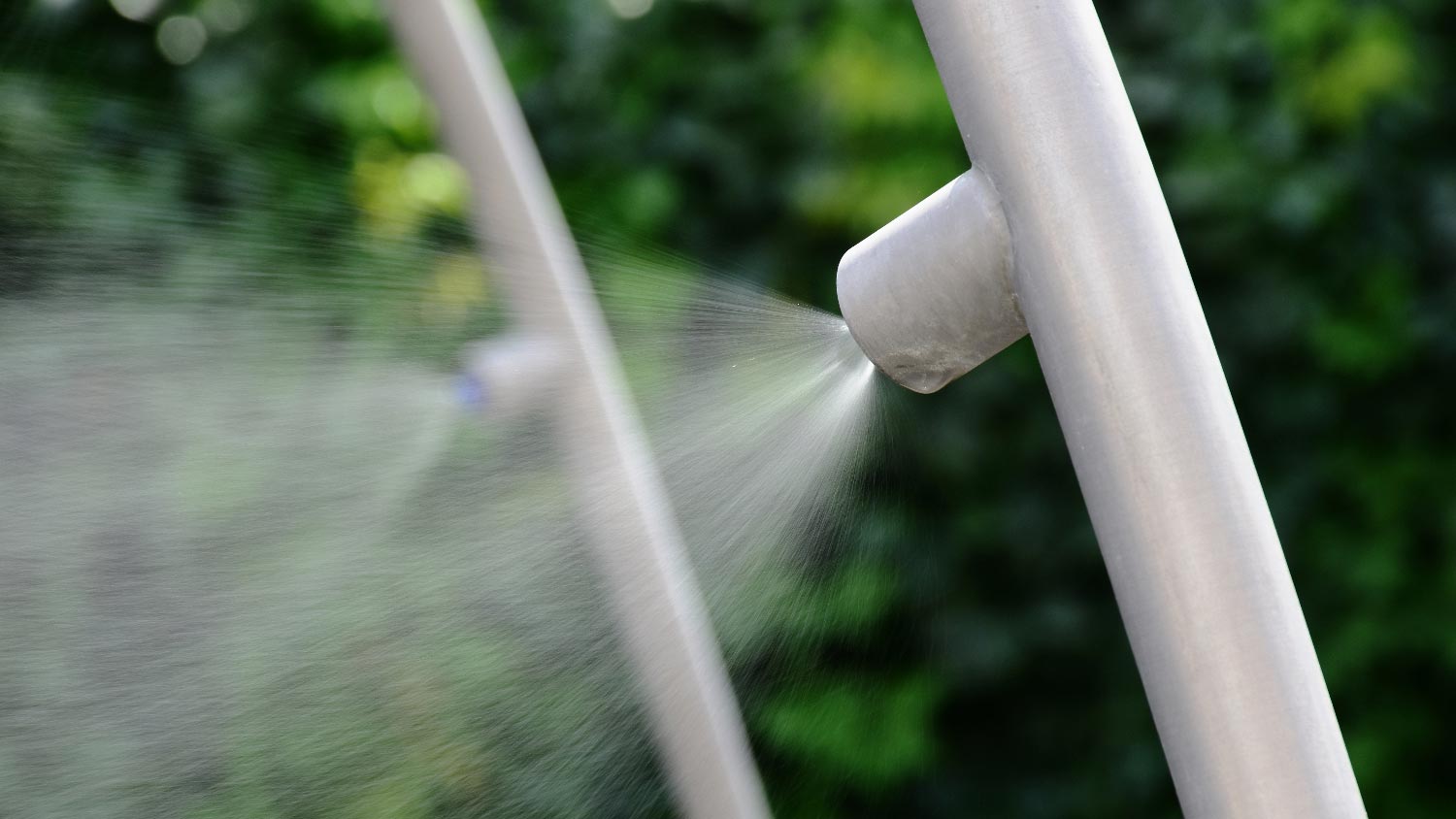
A French drain costs around $9,250 to install, but several factors will determine the final price you pay. Learn the cost to install French drains in this guide.
Misters are an efficient way to keep cool on hot days


Patio misters use 1 to 2 gallons of water per hour.
Misters can reduce temperatures by 30 degrees Fahrenheit or 10 to 15 degrees in high-humidity areas.
High pressure systems are the most effective for residential use.
Outdoor misting systems are an excellent way to keep cool when temperatures are running high. If you’re considering installing one, you’re likely wondering how much water misters use and if it’s worth the expense.
Let’s explore the details of how misters work, what determines water usage, and whether a misting system is worth the increase in water bills.
Patio misters work by using a pump that pressurizes water and forces it through nozzles with a small opening, making it into a fine mist. The water is dispersed through the nozzles, which break it into tiny droplets.
As the mist evaporates, it absorbs the heat from the surrounding areas and causes a cooling effect. Misting systems can cause felt temperatures to drop by 30 degrees Fahrenheit or 10 to 15 degrees Fahrenheit in high-humidity areas. These systems make you say goodbye to scorching summer BBQs and stay cool even during the intense mid-summer heat.
However, a misting system with standard nozzles typically uses 1 to 2 gallons of water per hour per nozzle. So, if you have a system with ten nozzles, you will use roughly ten gallons of water per hour. If your mister runs for three hours every day, that adds up to 30 gallons of water per day, totaling 210 gallons a week.
However, the amount of water misters use varies depending on the type of misting system, the number of nozzles, and the water pressure. A high-pressure water system uses less water and is more effective at cooling, but it is also more expensive. You can refer to the manufacturer's manual to find out the average water usage for your particular system or read the specifications for the system you want to purchase.

Reducing the amount of water misters use can help cut costs on your water bill. Here are a few ways you can help reduce the amount of water your misting system uses:
Adjust the misters: If your misters release larger water droplets, it could lead to water waste and less efficient cooling. Adjust the misters to spray a finer mist for lighter coverage.
Invest in a high-pressure misting system: While there are some very affordable low- pressure misting systems, they can use more water than their high-pressure counterparts. So, you may want to consider spending more upfront to save on water use later.
Install a timer or turn the system off: An effective way to reduce water use is to either turn the system off when you aren’t frequenting the area or install a smart timer to turn it off automatically.
Check for leaks: Regularly inspecting and cleaning your misting system can prevent you from wasting water if it is leaking.
There are simple misting systems available that you may be able to install yourself. But for more complex misting systems, it’s best to have a professional irrigation specialist near you install it because they have the expertise, tools, and equipment to ensure the installation is done correctly. A professional installation can prevent excessive water use and ensure the system operates properly.
While there are inexpensive low-pressure systems available, the average cost to install an outdoor system by a professional runs between $1,940 and $3,550. The price varies based on the type and size of the misting system and your location.
Even though your water bill may increase, misters may be worth the cost if you spend a lot of time in your outdoor space. Misters can provide relief from the heat if you live in a very hot and dry climate. So, rather than sweltering during the summer at your outdoor gatherings, you can keep cool and make your outings more enjoyable.
Of course, whether they are worth the cost depends on your outdoor needs and budget. But you can always implement water-saving techniques to help cut costs.
From average costs to expert advice, get all the answers you need to get your job done.

A French drain costs around $9,250 to install, but several factors will determine the final price you pay. Learn the cost to install French drains in this guide.

Discover drip irrigation system cost estimates, key price factors, and ways to save. Get transparent pricing to plan your home irrigation project confidently.

Find out the average sprinkler system repair cost, what impacts pricing, and how to save. Get transparent estimates to plan your sprinkler repair project.

Your backflow preventer is a critical component of your irrigation system, so it needs regular checkups that can only be done by a professional. Here’s who to call.

Wondering how to find irrigation valves on your property? Locating them can be challenging. Learn how to tackle this project with our guide.

Have you ever wondered, “How does a sprinkler valve work?” Dive into the details of this important component of your sprinkler system.